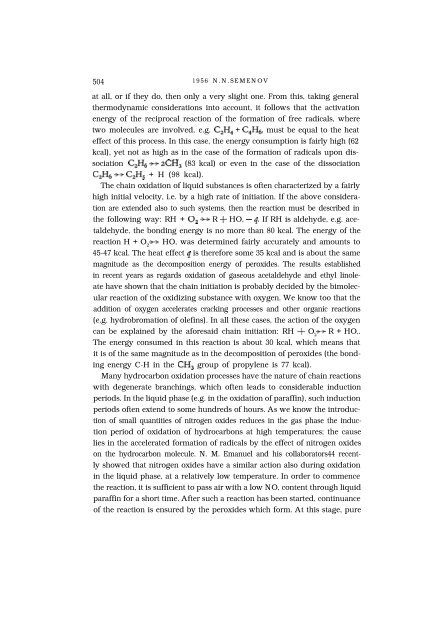Nikolai N. Semenov - Nobel Lecture - Nobelprize.org
Nikolai N. Semenov - Nobel Lecture - Nobelprize.org
Nikolai N. Semenov - Nobel Lecture - Nobelprize.org
You also want an ePaper? Increase the reach of your titles
YUMPU automatically turns print PDFs into web optimized ePapers that Google loves.
504 1956 N.N.SEMENOV<br />
at all, or if they do, then only a very slight one. From this, taking general<br />
thermodynamic considerations into account, it follows that the activation<br />
energy of the reciprocal reaction of the formation of free radicals, where<br />
two molecules are involved, e.g. C,H, + C4H(j, must be equal to the heat<br />
effect of this process. In this case, the energy consumption is fairly high (62<br />
kcal), yet not as high as in the case of the formation of radicals upon dissociation<br />
C,H6 +-t 2CH, (83 kcal) or even in the case of the dissociation<br />
CzH6 +-f C,Hs + H (98 kcal).<br />
The chain oxidation of liquid substances is often characterized by a fairly<br />
high initial velocity, i.e. by a high rate of initiation. If the above consideration<br />
are extended also to such systems, then the reaction must be described in<br />
the following way: RH + Oa -f+ R + HO, - 4. If RH is aldehyde, e.g. acetaldehyde,<br />
the bonding energy is no more than 80 kcal. The energy of the<br />
reaction H + O 2<br />
++ HO, was determined fairly accurately and amounts to<br />
45-47 kcal. The heat effect 4 is therefore some 35 kcal and is about the same<br />
magnitude as the decomposition energy of peroxides. The results established<br />
in recent years as regards oxidation of gaseous acetaldehyde and ethyl linoleate<br />
have shown that the chain initiation is probably decided by the bimolecular<br />
reaction of the oxidizing substance with oxygen. We know too that the<br />
addition of oxygen accelerates cracking processes and other <strong>org</strong>anic reactions<br />
(e.g. hydrobromation of olefins). In all these cases, the action of the oxygen<br />
can be explained by the aforesaid chain initiation: RH + O 2<br />
++ R + HO,.<br />
The energy consumed in this reaction is about 30 kcal, which means that<br />
it is of the same magnitude as in the decomposition of peroxides (the bonding<br />
energy C-H in the CH, group of propylene is 77 kcal).<br />
Many hydrocarbon oxidation processes have the nature of chain reactions<br />
with degenerate branchings, which often leads to considerable induction<br />
periods. In the liquid phase (e.g. in the oxidation of paraffin), such induction<br />
periods often extend to some hundreds of hours. As we know the introduction<br />
of small quantities of nitrogen oxides reduces in the gas phase the induction<br />
period of oxidation of hydrocarbons at high temperatures; the cause<br />
lies in the accelerated formation of radicals by the effect of nitrogen oxides<br />
on the hydrocarbon molecule. N. M. Emanuel and his collaborators44 recently<br />
showed that nitrogen oxides have a similar action also during oxidation<br />
in the liquid phase, at a relatively low temperature. In order to commence<br />
the reaction, it is sufficient to pass air with a low NO, content through liquid<br />
paraffin for a short time. After such a reaction has been started, continuance<br />
of the reaction is ensured by the peroxides which form. At this stage, pure
















